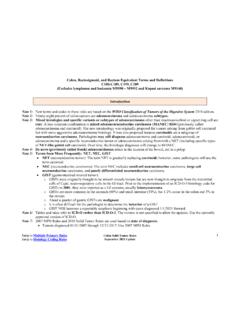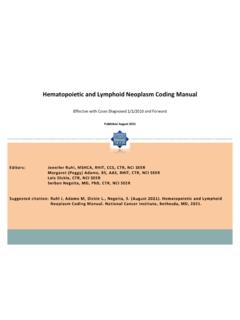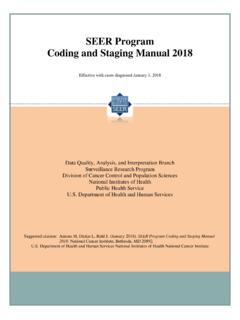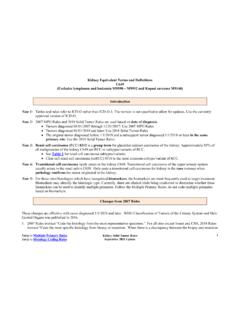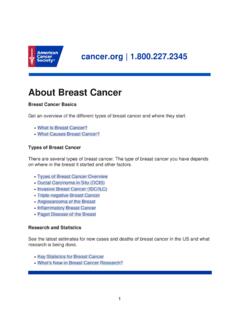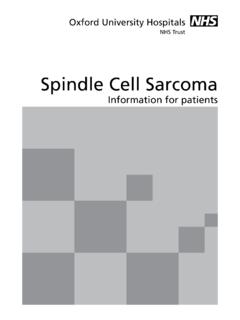Transcription of Malignant CNS and Peripheral Nerves Equivalent Terms and ...
1 Malignant CNS and Peripheral Nerves Equivalent Terms and Definitions C470-C479, C700, C701, C709, C710-C719, C720-C725, C728, C729, C751-C753 (Excludes lymphoma and leukemia M9590 M9992 and Kaposi sarcoma M9140) Jump to Multiple Primary Rules Jump to Histology Coding Rules Introduction Note 1: This section includes the following primary sites: Peripheral Nerves C470-C479; cerebral meninges C700; spinal meninges C701; meninges NOS C709; brain C710-C719; spinal cord C720; cauda equina C721; olfactory nerve C722; optic nerve C723; acoustic nerve C724; cranial nerve NOS C725; overlapping lesion of brain and central nervous system C728; nervous system NOS C729; pituitary gland C751; craniopharyngeal duct C752; pineal gland C753.
2 Note 2: Non- Malignant intracranial and CNS tumors have a separate set of rules. Note 3: 2007 MPH Rules and 2018 Solid Tumor Rules are used based on date of diagnosis. Tumors diagnosed 01/01/2007 through 12/31/2017: Use 2007 MPH Rules Tumors diagnosed 01/01/2018 and later: Use 2018 Solid Tumor Rules The original tumor diagnosed before 1/1/2018 and a subsequent tumor diagnosed 1/1/2018 or later in the same primary site: Use the 2018 Solid Tumor Rules. Note 4: There must be a histologic, cytologic, radiographic, or clinical diagnosis of a Malignant neoplasm /3. Note 5: Tumors from a number of primary sites metastasize to the brain. Do not use these rules for tumors described as metastases; report metastatic tumors using the rules for that primary site.
3 Note 6: Pilocytic astrocytoma/juvenile pilocytic astrocytoma is reportable in North America as a Malignant neoplasm 9421/3. See the Non- Malignant CNS Rules when the primary site is optic nerve and the diagnosis is either optic glioma or pilocytic astrocytoma. The behavior for these tumors is non- Malignant and coded 9421/1. Note 7: Tables and rules refer to ICD-O rather than ICD-O-3. The specific version is not specified to allow for updates. Use the currently approved version of ICD-O and all updates. Note 8: For those sites/histologies which have recognized biomarkers, the biomarkers may aid in the identification of histologic type. Currently, there are clinical trials being conducted to determine whether these biomarkers can be used to identify multiple primaries.
4 Follow the Multiple Primary Rules; do not code multiple primaries based on biomarkers. Note 9: See the Head and Neck Rules for coding paragangliomas. Malignant CNS Solid Tumor Rules September 2021 Update1 Malignant CNS and Peripheral Nerves Equivalent Terms and Definitions C470-C479, C700, C701, C709, C710-C719, C720-C725, C728, C729, C751-C753 (Excludes lymphoma and leukemia M9590 M9992 and Kaposi sarcoma M9140) Jump to Multiple Primary Rules Jump to Histology Coding Rules Equivalent or Equal Terms These Terms can be used interchangeably: And; with Note: And and with are used as synonyms when describing multiple histologies within a single tumor.
5 Cerebrospinal fluid; CSF Dura; meninges Extradural; not within the meninges; within the cranium; within the skull but not within the cerebral meninges Extramedullary; outside medulla oblongata C700 Infratentorial; below the tentorium cerebelli; either cerebellum or brainstem Intracranial; within the skull, within the cranium Intradural; between layers of the cerebral meninges; C700 Intradural-extramedullary; within the spinal canal but outside of the Nerves Intraspinal; occurring within the spinal column especially the vertebral canal; spinal nerve roots Site; topography Supratentorial; above the tentorium cerebelli; cerebrum o Cerebrum contains frontal lobe, parietal lobe, occipital lobe, and temporal lobe Tentorium cerebelli; cerebellar tentorium Tumor; mass; lesion; neoplasm when o These Terms are used ONLY to determine multiple primaries o Do not use these Terms for casefinding or determining reportability Type; subtype; variant WHO Grade 3 and WHO Grade 4; Malignant ; invasive.
6 /3 Malignant CNS Solid Tumor Rules September 2021 Update2 Malignant CNS and Peripheral Nerves Equivalent Terms and Definitions C470-C479, C700, C701, C709, C710-C719, C720-C725, C728, C729, C751-C753 (Excludes lymphoma and leukemia M9590 M9992 and Kaposi sarcoma M9140) Jump to Multiple Primary Rules Jump to Histology Coding Rules Terms that are NOT Equivalent or Equal This is a term that is not Equivalent . There are no casefinding implications. Component is not Equivalent to subtype/type/variant Note: Component is only coded when the pathologist specifies the component as a second carcinoma. Phenotype is not Equivalent to subtype/type/variant WHO Grade is not Equivalent to tumor grade Changes from 2007 MPH Rules These changes are effective with cases diagnosed 1/1/2018 and later.
7 1. 2016 CNS WHO presents major restructuring of the diffuse gliomas, medulloblastomas and other embryonal tumors, and incorporates new entities that are defined by both histology and molecular features, including glioblastoma, IDH-wildtype and glioblastoma, IDH-mutant; diffuse midline glioma, H3 K27M-mutant, RELA fusion-positive ependymoma, medulloblastoma, WNT-activated and medulloblastoma, SHH-activated, and embryonal tumor with multilayered rosettes, C19MC-altered. The 2016 edition has added newly recognized neoplasms and has referred to some entities, variants and patterns as not recommended (previously called obsolete). A. It has been determined that these not recommended Terms no longer have diagnostic and/or biological relevance.
8 For example, gliomatosis cerebri is a term which is no longer recommended. Gliomatosis cerebri is now termed a growth pattern rather than a histologic type. B. Terms which are not recommended are not included in the tables. When one of these Terms are used, refer to the ICD-O and all updates for the correct histology code. For example, glioma NOS is an umbrella term for all gliomas and astrocytomas. Glioma NOS is not recommended because diagnostic methodology is able to determine a more specific diagnosis. 2. Rule change: The 2007 rules said a glioblastoma multiforme (GBM) following an astrocytic or glial tumor was a single primary (recurrence).
9 In the 2018 Solid Tumor Rules, GBM subsequent to an astrocytic or glial tumor is a multiple primary. GBM is now being collected as a new primary so it is possible to analyze the frequency with which these tumors recur in a more aggressive form (GBM). Malignant CNS Solid Tumor Rules September 2021 Update3 Malignant CNS and Peripheral Nerves Equivalent Terms and Definitions C470-C479, C700, C701, C709, C710-C719, C720-C725, C728, C729, C751-C753 (Excludes lymphoma and leukemia M9590 M9992 and Kaposi sarcoma M9140) Jump to Multiple Primary Rules Jump to Histology Coding Rules 3. Clarifications: A. The following meningiomas are reportable: intraosseous, cavernous sinus and sphenoid wing.
10 B. Multiple cerebral meningiomas are a single primary. C. Multiple brain tumors (same histology) are a single primary. D. Laterality is not used to determine multiple primaries. E. Timing is not used to determine multiple primaries. F. The brain (C710-C719) is a single primary site. G. Neurofibromatosis NOS, Neurofibromatosis 1 (NF1), Neurofibromatosis 2 (NF2), and schwannomatosis are genetic syndromes and not reportable neoplasms. People with this genetic syndrome do have a high risk of developing: i. Non-reportable non- Malignant tumors occurring in skin and sites other than CNS AND ii. Reportable Malignant tumors 4. The 2016 World Health Organization (WHO) Classification of Tumors of the Central Nervous System (CNS) contains newly recognized histologies and subtypes/variants.


